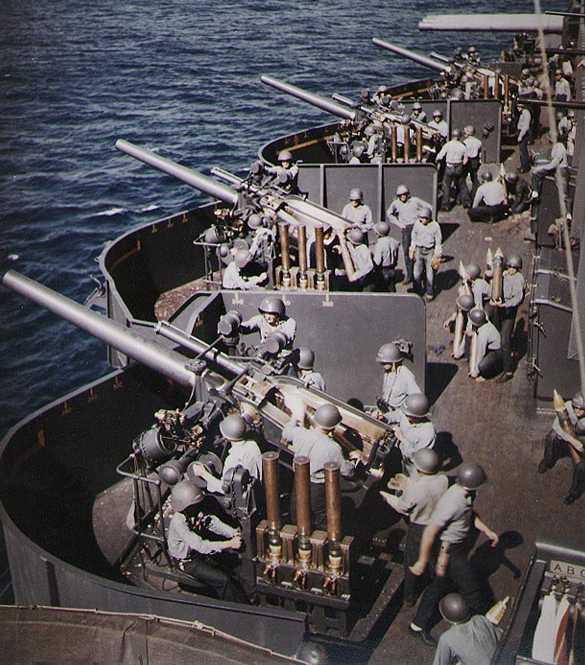
This was the first USN heavy AA gun designed for the purpose and was used on most USA capital ships and cruisers built or modernized between 1926 and 1940. When these weapons started to appear on battleships, the gunnery officers began thinking of them as dual-purpose weapons and often fired them in the annual surface gunfire contests with impressive results.
The mountings for this weapon were lightly built in order to give them the lowest possible moment of inertia and thus the highest possible speeds for manual training and elevation. As a result, these guns had about one-third the moment of inertia for train as did the 5"/51 (12.7 cm) anti-torpedo boat mountings. This requirement led to a short barrel in order to keep the weight down, which in turn resulted in a relatively low muzzle velocity, but this was considered to be acceptable for an AAA weapon. In the early 1930s these guns were briefly considered for arming new construction destroyers, but they were ultimately rejected in favor of a new design, the famous 5"/38 (12.7 cm) Mark 12.
On 15 February 1942 while escorting a convoy near Timor, USS Houston (CA-30) was attacked by nine Kawanishi H6K Type 97 ("Mavis") four-engine flying boats and thirty-six Mitsubishi Ki-21 Type 97 ("Sally") twin-engine bombers. Houston claimed to have shot down seven of these aircraft with her 5"/25 (12.7 cm) guns, firing a total of 930 rounds during the 45 minute action.
All early models were constructed using a monobloc barrel. The prototype was a Mark 3 Mod 0 cut down to 25 calibers and then designated as Mark 3 Mod 3. The Mark 10 Mod 0 had an autofretted barrel with a threaded and shrunk-on housing and used a vertical semi-automatic sliding breech block with no loading tray. The Mark 10 Mod 1 used a threaded barrel keyed to the housing. Mark 10 Mod 2 added a loading tray and pneumatic ramming. Mark 10 Mod 3 had part of the left housing cut away to ease loading. The Mark 11 added chromium plating to the bore. Mark 13 was similar to the Mark 11, but the barrel and housing were joined by a bayonet joint to allow easy barrel replacement, a feature found in all subsequent US 5" (12.7 cm) designs.
The Mark 17 was a "wet mount" version for submarines and was unusual in that it did not require breech or muzzle plugs. This was because it used a special liner resistant to corrosion from sea water and could thus be submerged and flooded without harm to the gun. The Mark 17 Mod 0 used a tube of higher strength steel than that used for earlier Marks and had a shrunk forged copper-nickel alloy liner. The Mark 17 Mod 1 was a bored out Mark 13 Mod 0 fitted with a tapered copper-nickel alloy liner. Both Mods of the Mark 17 had chrome-plated bores and lacked the pneumatic rammers used on other Marks. This was acceptable as the Mark 40 mounting used on submarines was an SP type with a maximum elevation of 40 degrees.
| Designation | 5"/25 (12.7 cm) Marks 10, 11, 13 and 17 |
|---|---|
| Ship Class Used On | Lexington (CV-2), Ranger (CV-4), Nevada (BB-36), Pennsylvania (BB-38), New Mexico (BB-40), Tennessee (BB-43), Colorado (BB-45),
Pensacola (CA-24), Northampton (CA-26), New Orleans (CA-32), Portland (CA-33) and Brooklyn (CL-40) classes
Submarines in the 1940s |
| Date Of Design | 1921 |
| Date In Service | 1926 |
| Gun Weight | Barrel Weight (all except Mark 17): 2,105 lbs. (955 kg)
Barrel Weight (Mark 17): 2,163 lbs. (981 kg) Weight with housing: about 4,270 lbs. (1,937 kg) |
| Gun Length oa | 142.25 in (3.613 m) |
| Bore Length | 125 in (3.175 m) |
| Rifling Length | 98.1 in (2.492 m) |
| Grooves | (45) 0.05 in deep (1.27 mm) |
| Lands | N/A |
| Twist | Uniform RH 1 in 25 |
| Chamber Volume | 431 in3 (7.06 dm3) |
| Rate Of Fire | 15 - 20 rounds per minute |
| Type 1 | Fixed |
|---|---|
| Weight of Complete Round | about 80 lbs. (36.3 kg) |
| Projectile Types and Weights | HC Mark 36: 53.85 lbs. (24.43 kg)
AA Common Mark 28 Mods 1 to 8 2 3: 54.0 lbs. (24.49 kg) AA Common Mark 36 2 3: 53.85 lbs. (24.43 kg) VT AA Common Mark 28 Mod 9 3: 51.7 lbs. (23.45 kg) VT AA Common Mark 36 Mods 2 and 4 3: 54 lbs. (24.49 kg) Illum Mark 25 Mod 2: 54.5 lbs. (24.7 kg) Illum Mark 27 Mods 1 to 4: 53.65 lbs. (24.33 kg) Illum Mark 27 Mods 5 to 10: 54.5 lbs. (27.7 kg) Illum Mark 45 Mod 0: 54.5 lbs. (27.7 kg) |
| Bursting Charge | AAC Mark 28: 7.33 lbs. (3.32 kg) Explosive D, Composition A
AAC Mark 36: 7.25 lbs. (3.29 kg) Explosive D, Composition A Others:N/A |
| Projectile Length | AAC, HC and VT AAC: 20.70 in (52.6 cm)
Illum: 20.0 in (50.8 cm) |
| Cartridge Case Type, Size and Empty Weight | Mark 4 Mod 0: Brass, 127 x 626 mm, 14.44 lbs. (6.55 kg)
Mark 4 Mod 2: Brass, 127 x 626 mm, 11.40 lbs. (5.17 kg) |
| Propellant Charge | 9.6 lbs. (4.35 kg) SPD or SPDN 4 |
| Muzzle Velocity | 2,155 fps (657 mps) |
| Working Pressure | 16.7 tons/in2 (2,630 kg/cm2) |
| Approximate Barrel Life | 3,000 rounds 5 |
| Ammunition stowage per gun | about 200 rounds |
- ^A Note on Sources: In both "United States Naval Guns: Marks and Modifications: Service Guns - OP 127" and in Campbell's "Naval Weapons of World War Two" it is stated that the Mark 17 Mod 1 fired semi-fixed (separate) ammunition. Prompted by my friend Tony Williams, I started wondering why the USN would have both a semi-fixed and a fixed ammunition design for the same basic wet-gun application. This would imply that submarines would need two different kinds of ammunition for the same gun type and that this would again be different than the same ammunition supplied for surface ships, a very unusual situation for the standardization-prone USN.
Thus stimulated, I dug through more of my references. I found that the OP 1029 handbook on the Mark 40 submarine wet-mount makes no mention of a semi-fixed version. My 1947 copy of OP 1664, my primary reference for World War II USN ammunition, only notes fixed 5"/25 (12.7 cm) ammunition and cartridge cases, there are no semi-fixed Marks or Mods listed. In looking again at OP 127, even though it says that the Mod 1 was a semi-fixed gun, it also says that the Mod 1 is essentially identical to the Mod 0 and that all internal dimensions are identical between the two Mods. Semi-fixed guns must have either a longer chamber and thus a shorter rifling length than fixed guns or else have a shorter casing in order to accommodate the greater length of semi-fixed ammunition - see the British 4.5"/45 (11.4 cm) QF Marks I, III and IV datapage for an example of using different casings. As neither of these conditions existed for the USA 5"/25 (12.7 cm), I have concluded that both submarine Mods were fixed-ammunition guns and that there was an error in OP 127 that Campbell later repeated.
- ^2.12.2The AAC Mark 28 and AAC Mark 36 projectile bodies could be used with Point Detonating (PD), Mechanical Time (MT) or with proximity (VT) fuzes. When used with PD fuzes, they were considered to be HC rounds. As the VT fuze was larger than the other ones, only certain projectile Mods could use it.
- ^Some SPD and SPDN cartridges had flashless pellets added which gave them a "reduced" flash.
- ^I believe this life figure to be for the non-plated bore version. The figure for weapons with chromium plated bores would be about 20% higher.
| Elevation | Range | Angle of Fall | Time of Flight | Striking Velocity | Maximum Ordinate |
|---|---|---|---|---|---|
| 3.63 degrees | 4,000 yards (3,658 m) | 4.82 degrees | 7.28 seconds | 1,299 fps (396 mps) | 213 feet (649 m) |
| 15.83 degrees | 10,000 yards (9,140 m) | 26.42 degrees | 26.07 seconds | 895 fps (273 mps) | 2,920 feet (890 m) |
| 33.22 degrees | 14,000 yards (12,802 m) | 49.53 degrees | 47.12 seconds | 898 fps (274 mps) | 9,440 feet (2,877 m) |
| 40.00 degrees | 14,200 yards (12,984 m) | N/A | N/A | N/A | N/A |
| 45.00 degrees | 14,500 yards (13,259 m) | N/A | N/A | N/A | N/A |
| 85.00 degrees | N/A | N/A | N/A | N/A | 27,400 feet (8,252 m) |
| Designation 1b | Pedestal Single Mounting - Marks 17, 19, 23 and 27 2b Carriers Lexington (12), Ranger (8): Mark 19 Battleships
Cruisers
|
|---|---|
| Weight | Mark 23: 21,670 lbs. (9,829 kg)
Mark 27: 23,270 lbs. (10,555 kg) Mark 40: 12,600 to 14,000 lbs. (5,715 to 6,350 kg) |
| Elevation | Marks 17, 19, 23 and 27: -15 / +85 degrees
Mark 19 mods 24, 25 and 26: -10 / +85 degrees Mark 40: -10 / +40 degrees |
| Elevation Rate | Mark 19: Manual operation, only 7b Mark 23: N/A Mark 27: 30 degrees per second 8b Mark 40: Manual operation, only |
| Train | All except Mark 40: about +150 / -150 degrees
Mark 40: +158 / -158 degrees |
| Train Rate | Mark 19: Manual operation, only 7b Mark 23: N/A Mark 27: 20 degrees per second 8b Mark 40: Manual operation, only |
| Gun recoil | AA Guns: 12 to 24 inches (30 to 61 cm)
9b Mark 40: 20 inches (51 cm) |
- ^The number of mountings given above are as the ships were originally commissioned or modified. These quantities changed during World War II as some ships had these guns replaced by light AA or by the 5"/38 (12.7 cm) Mark 12. Conversely, USS Mississippi (BB-41) landed all of her 5"/51 (12.7 cm) SP guns during a refit in 1945 and then carried a total of sixteen 5"/25 (12.7 cm) AA guns.
- ^The Mark 17 was the first USN heavy AA mount and was used for proving ground testing but not used afloat. This Mark had a trunnion height of 60 inches (152 cm), but no platform for the loader. It used the Mark 10 Mod 0 and Mod 1 guns which did not have a loading tray and were manually rammed. The Mark 19 was the first ship-borne mounting and added a loader's platform, raised the trunnion height to 66 inches (168 cm) and used the Mark 10 Mod 2 and Mod 3 guns which added a loading tray and pneumatic ramming. The Mark 23 was an improved power-driven mounting and could be used with the Mark 33 director. The Mark 27 was a late-war power-driven mount and generally had RPC. From an examination of photographs, it appears that those ships refitted with Mark 33 or Mark 37 fire control systems during the war were also refitted with Mark 23 or Mark 27 gun mountings. For example, this NavSource photograph of a gun from USS Tuscaloosa (CA-37) shows what I believe is a Mark 27 Mounting which was probably added during her refit in September 1944.
- ^The Mark 23 allocations shown here are based upon these ships having the Mark 33 director system.
- ^The Mark 40 was a SP wet mount for submarines. Trunnions were 48 inches (122 cm) above the mounting deck.
- ^Many submarines had their 3"/50 (7.62 cm) gun replaced by a 5"/25 (12.7 cm) during World War II. USS Spadefish (SS-411), commissioned on 9 March 1944, was the first submarine with a 5"/25 (12.7 cm) gun as commissioned. Submarines completed late in the war were typically equipped with two 5"/25 (12.7 cm) gun foundations, but had only one gun fitted. The gun was located forward or aft at the CO's discretion. In January 1945, USS Sennet (SS-408) was the first submarine fitted with two 5"/25 (12.7 cm) guns. After she made a very successful patrol with two other similarly armed boats, OpNav authorized this arrangement for any submarine whose CO wanted it. A major post-war goal for the US submarine force was to acquire enough 5"/25 (12.7 cm) guns so as to have two available for all active and reserve submarines.
- ^Some guns used on submarines may have been modified weapons that had been removed from the battleships.
- ^8.18.2The elevation and training speeds shown for the Mark 27 mounting were for automatic (director) mode, in local mode they were 32.6 and 22.0 degrees per second, respectively. The Mark 27 mounts used on some Brooklyn (CL-40) class cruisers had 3 hp elevating and training motors and a hydraulic rammer driven from a 5 hp motor.
- ^Recoil distances depended on the type of ship the weapons were mounted on. Battleships and cruisers had short-recoil mounts, as their much heavier structures could absorb the forces involved, while smaller ships had longer recoils so as to reduce the peak force.
- Most submarines lacked effective surface fire control systems, but seven submarines (SS-229, 340, 399, 401, 406, 407 and 408) were converted to "gunboats" during 1945. These boats carried two 5"/25 (12.7 cm) guns, a Mark 6 stable vertical, a Mark 6 computer and a gun plot installed in the forward crew quarters. The computer drove repeaters at the guns.
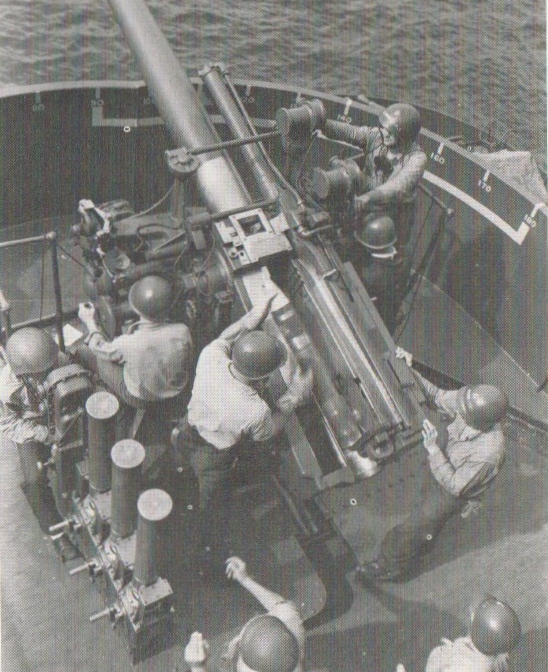
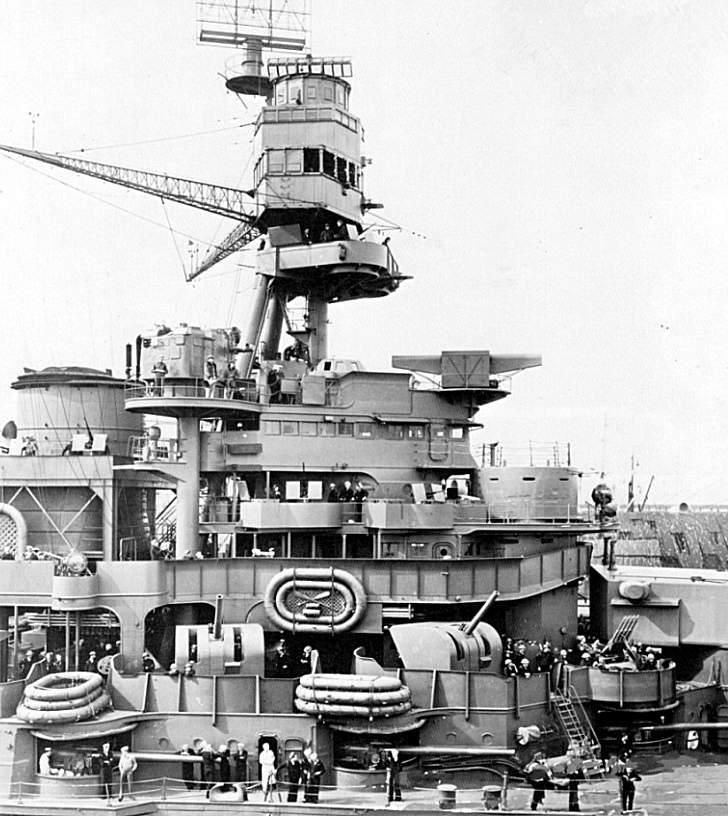
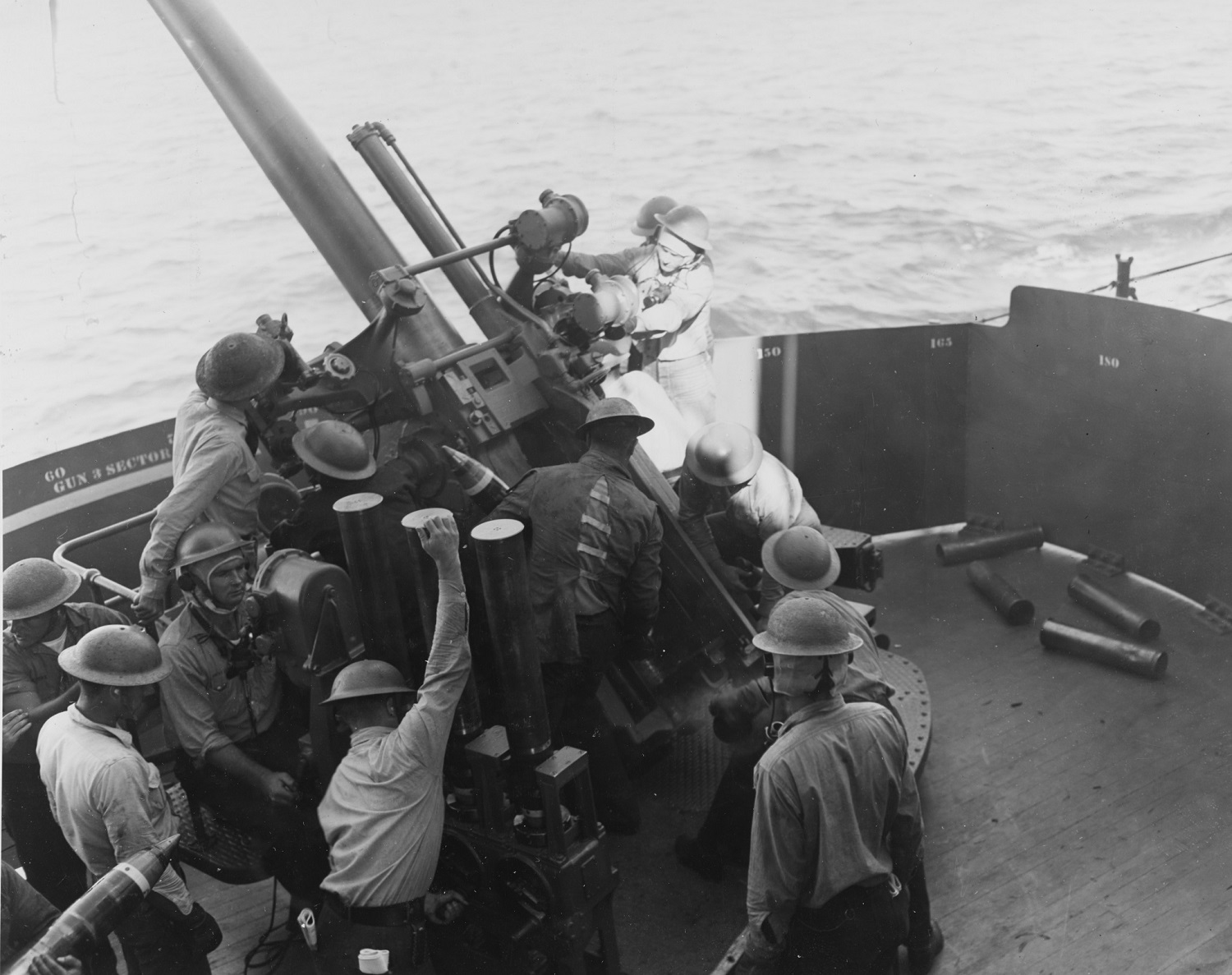
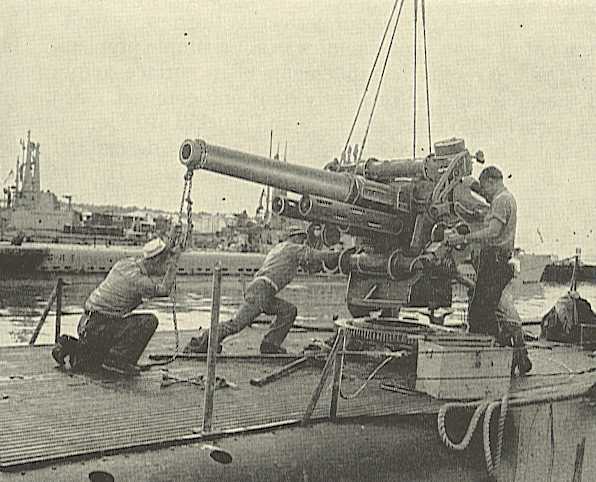
Compare the recoil gear on this submarine mounting with the "dry" mountings above.
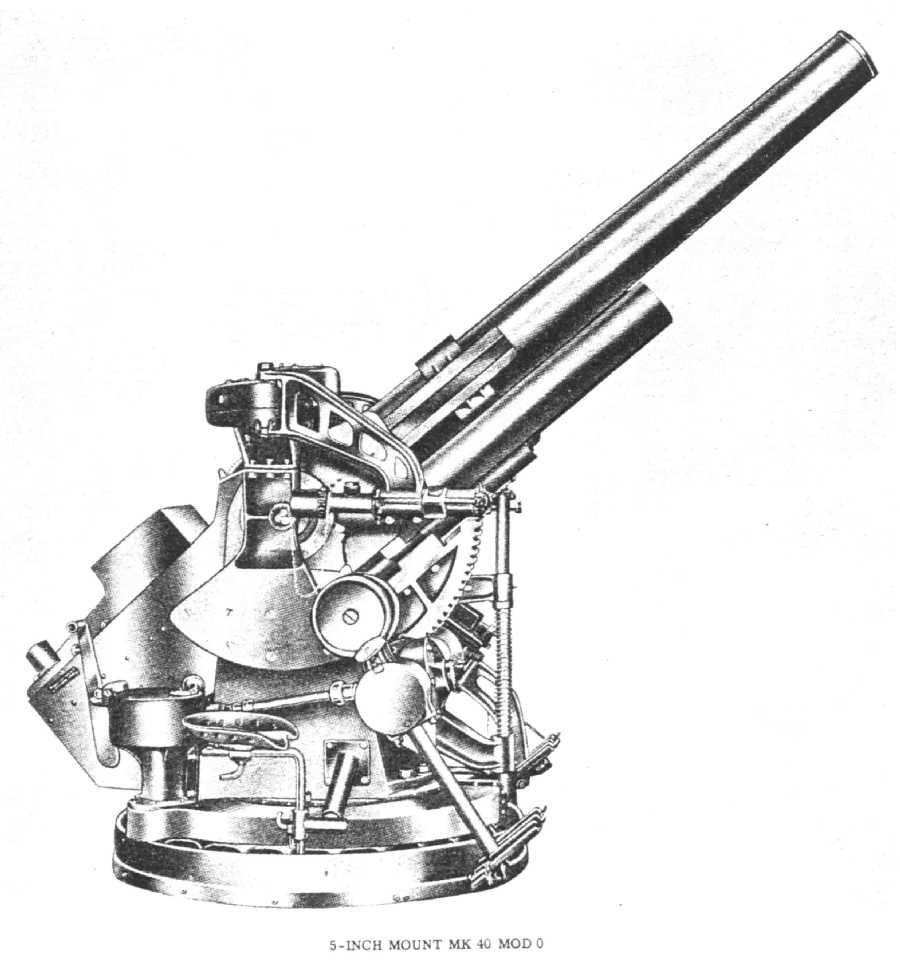
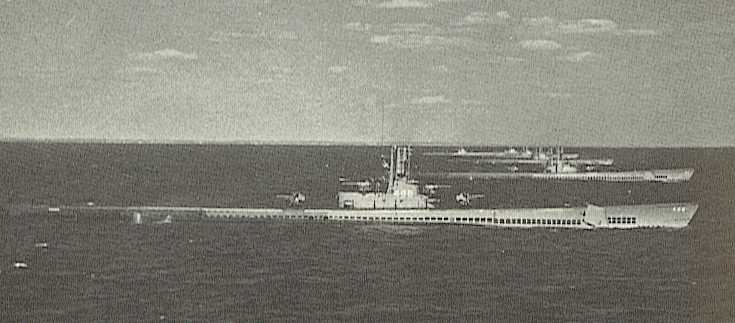
The submarine closest to the camera appears to be USS Sennet (SS-408).
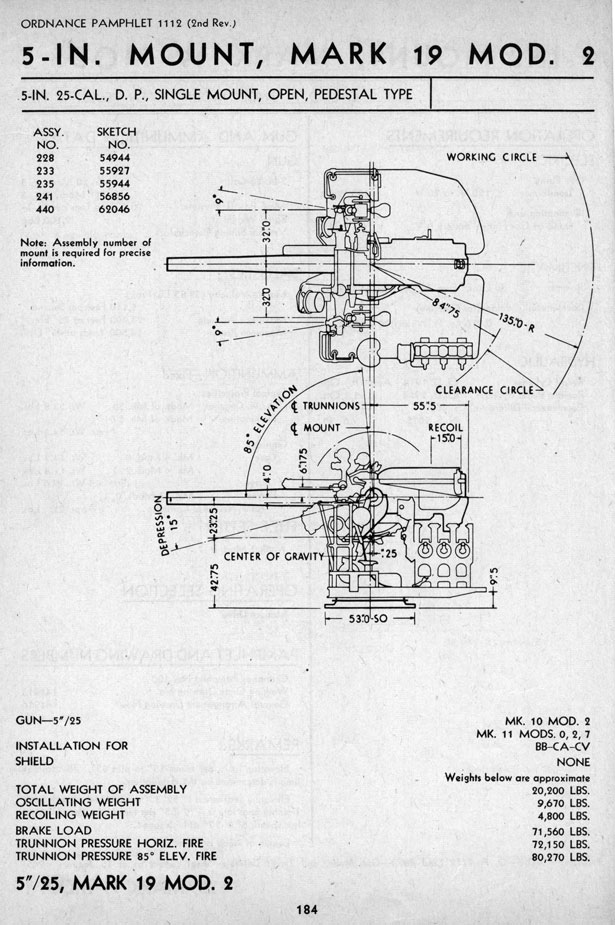
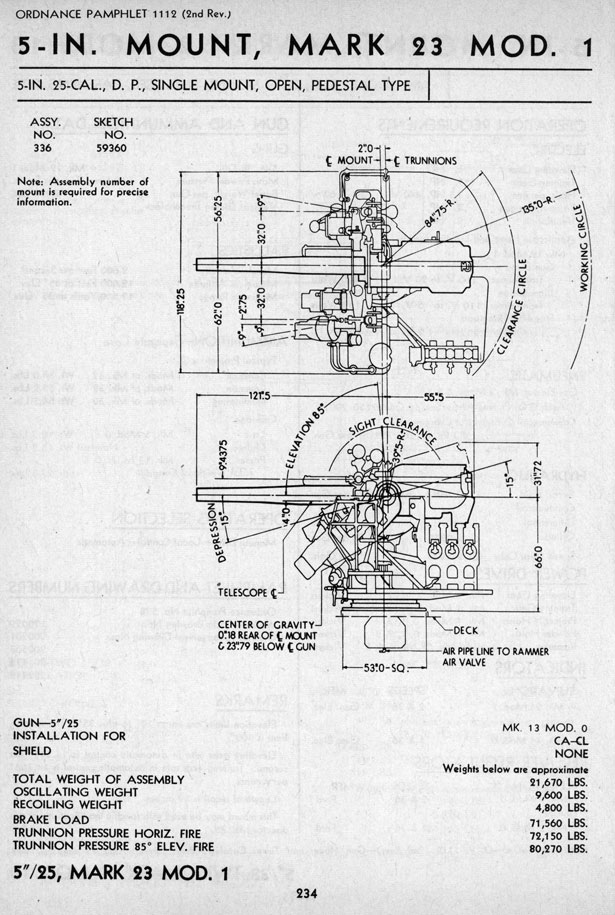
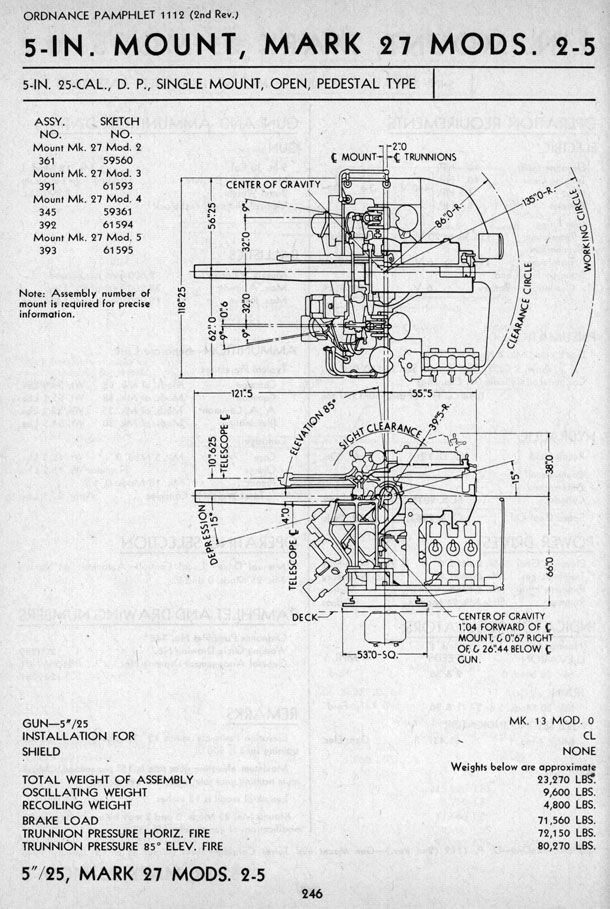
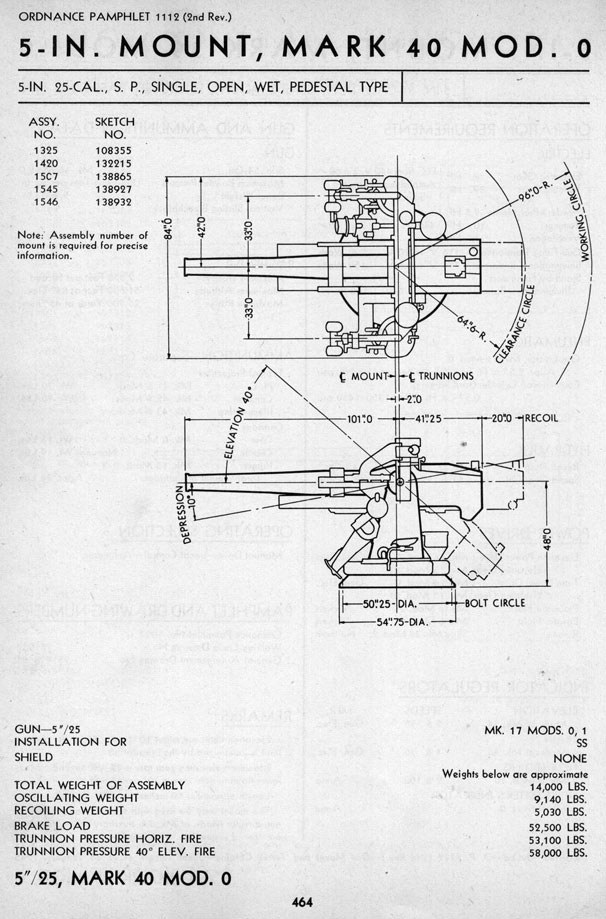
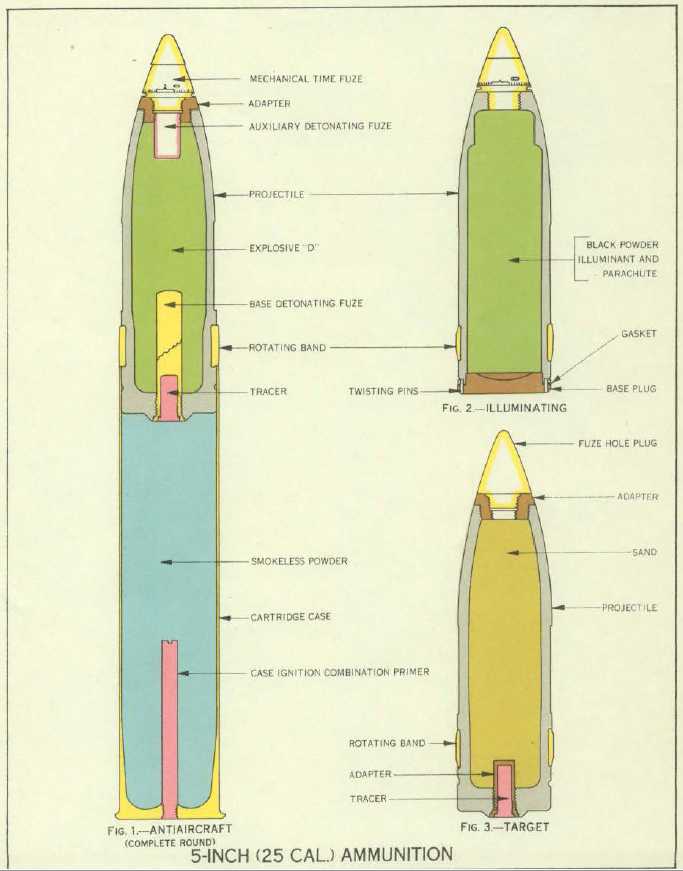
"Naval Weapons of World War Two" by John Campbell
"US Naval Weapons," "US Submarines through 1945: An Illustrated Design History," "The Naval Institute Guide to World Naval Weapon
Systems 1991/92" and "The American 5inch/38 Dual Purpose Gun" article in "Warship Volume II" all by Norman Friedman
"Ship of Ghosts: The Story of the USS Houston" by James D. Hornfischer
"A Treatise on Rifling of Guns" by Carl F. Jeansén
"The Evolution of Battleship Gunnery in the U.S. Navy, 1920-1945" article by William Jurens in "Warship International No. 3, 1991"
"U.S. Navy Bureau of Ordnance in World War II" by Lt. Cmdr. Buford Rowland, USNR, and Lt. William B. Boyd, USNR
---
"Ammunition: Instructions for the Naval Service: Ordnance Pamphlet 4 - May 1943" by Department of the Navy
"Abridged Range Tables for U.S. Naval Guns: Ordnance Pamphlet No. 1188, 13 June 1944" by Bureau of Ordnance (BuOrd), Department of the Navy
"U.S. Explosive Ordnance - Ordnance Pamphlet No. 1664 - May 1947" by Bureau of Ordnance (BuOrd), Department of the Navy
---
5-inch Gun Mount Mark 40 - OP 1029 at Historic Naval Ships Association
United States Naval Guns, Marks and Modifications: Service Guns - Ordnance Pamphlet No. 127 - 1956" by Bureau of Ordnance (BuOrd), Department of the Navy
at Gene Slover's Navy Pages
---
Special help from Leo Fischer
10 March 2008 - Benchmark
30 November 2009 - Corrected typographical error and adjusted description of nose fuzes
14 January 2011 - Added cutaway sketch
20 January 2011 - Changed Mark 17 Mod 1 to fixed ammunition, added links to OP 1029 at HNSA and to OP 127 at Gene Slover's Navy Page
03 September 2012 - Fixed typographical error
02 June 2014 - Added comment about chamber length of semi-fixed guns
23 May 2018 - Converted to HTML 5 format and reorganized notes
11 January 2019 - Added mounting sketches
28 August 2019 - Added information about Mark 17 and Mark 19 mountings
27 September 2020 - Added use on USS Lexington (CV-2) and Ranger (CV-4) classes, added notes on mountings
11 October 2021 - Added link to Mechanical Fuze Setter
09 August 2023 - Revised range table
